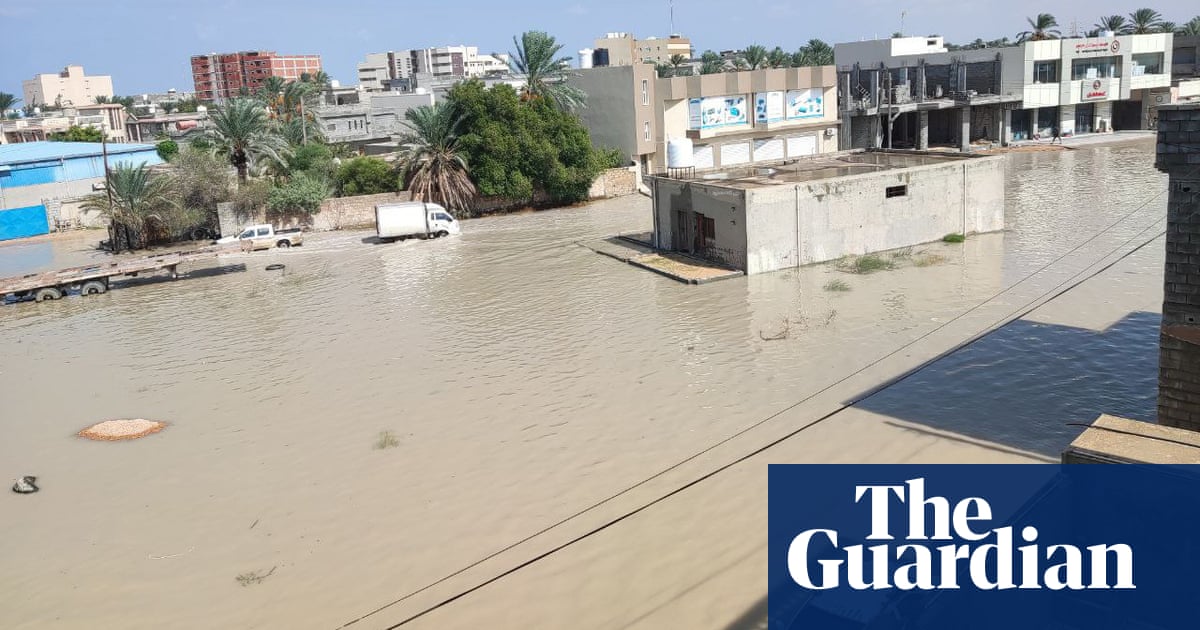The northeastern region of Libya has been overwhelmed by devastating flooding caused by Storm Daniel, resulting in the loss of thousands of lives and widespread destruction. This catastrophic event has exposed significant weaknesses in Libya’s infrastructure and has raised concerns about the country’s ability to respond to such crises.

Also Read: Burning Man Exodus Begins after Flooding Trapped Desert
Storm Daniel, which unleashed a torrent of rain over Libya’s northeast, has left a trail of destruction in its wake. The rainfall was so excessive that two dams in the region collapsed, leading to the catastrophic flooding that inundated cities and towns.
The size of the Storm Daniel is staggering, with around 22,000 confirmed deaths and an estimated 10,000 people still missing. These numbers are expected to rise as rescue and recovery efforts continue.
Derna, a city in Libya’s eastern region, has borne the brunt of the disaster. Reports from the ground paint a grim picture, with as many as 6,000 people missing in this city alone.
Whole neighborhoods have been obliterated by the rushing floodwaters, leaving behind scenes of utter devastation. Bodies of victims are still scattered throughout the city, and some are feared to have been swept away into the sea.
Also Read: Antarctica: Australia Evacuates Sick Researcher from Outpost
The collapse of two dams, overpowered by the power of the flooding, triggered the calamity in Derna. The floodwaters cleared away whole areas, causing severe damage to bridges and roads.
Infrastructure in valleys was particularly susceptible to the strong muddy currents, resulting in the destruction of homes, vehicles, and workplaces. The Storm Daniel has exposed significant shortcomings in Libya’s preparedness and infrastructure resilience.
Libya’s ability to respond effectively to this catastrophe has been hindered by a decade-long power struggle between two rival administrations, the UN-backed Government of National Unity (GNU) in Tripoli and the eastern-based government led by Commander Khalifa Haftar.
Derna, which is under Haftar’s control, has faced additional challenges due to political fractures, making it difficult to coordinate rescue and relief efforts. Phone lines in the city are down, further complicating the situation.
A few nations, including Turkey, the US, the United Arab Emirates, and Egypt, have offered help and backing to Libya in this time of emergency.
Also Read: Burning Man Festival: 70,000 People are Stranded due to Heavy Rains
Turkish airplane have previously shown up in Libya with humanitarian aid, and the US Embassy in Tripoli has declared a humanitarian need, authorizing initial funding for relief efforts. Egypt has also pledged to deploy military equipment and personnel to assist affected communities.
Scientists have emphasized that human-caused climate change is exacerbating the intensity and frequency of extreme weather events, including storms and flooding.
Warmer oceans provide storms with more energy, and the Mediterranean’s above-average sea temperatures likely contributed to the intensity of Storm Daniel. This disaster serves as a stark reminder of the urgent need to address climate change on a global scale.
Scientists have emphasized that human-caused climate change is exacerbating the intensity and frequency of extreme weather events, including storms and flooding.
Warmer oceans provide storms with more energy, and the Mediterranean’s above-average sea temperatures likely contributed to the intensity of Storm Daniel. This disaster serves as a stark reminder of the urgent need to address climate change on a global scale.
Also Read: Iceland Resumes Whale Hunting under Strict Rules
Top Sources Related to Storm Daniel: At least 2,000 Dead and 10,000 Missing in Libya (For R&D)
CNN News:
AP News:
Sources Related to Floods in Last 3 Months Around the World (For R&D)
- China floods: Xi Jinping urges action as rains kill 15 and displace thousands
- At Least 1 Dead as Heavy Rains Set Off Flash Flooding in New York
- Mongolia – Floods
- Assam Floods: About 18,000 People Suffer From Terrible Flood In Dhemaji District
- At least 50 dead in Pakistan monsoon floods since end of June
- New Delhi Floods: Deadly Monsoon Rains, leaving 15 Dead
- Japan Floods: Heavy Rains Causes Floods and Landslides, 1 Dead
- South Korea Floods: At Least 26 Dead and Over 1000 Evacuated
- Central Russia:10 Dead, Including 3 Children as Strong Winds hit Tourist Camp
- Typhoon Doksuri: Beijing’s Heaviest Rain in a Decade Kills at Least 11
- Slovenia Floods: At least 2 Dead, Forcing Evacuations
- Georgia: 11 Killed in Landslide at Mountain Resort Town of Shovi
- Alaska: Houses Swept Away by Glacial Floods in Juneau
- Nepal: At Least 38 Killed, Several Missing in Floods And Landslides
- China: 21 Killed, 6 Missing After Mudslide in Xi’an
- Hurricane Hilary hits California after Lashing Mexico
- Pakistan: Floods Force Evacuation of Almost 100,000 People
- Himachal Pradesh Landslide: 8 buildings Collapsed in Kullu
- Hurricane Idalia Makes Landfall in Florida and Georgia
- Typhoon Saola Threatens China with Category 4 Winds
- Typhoon Haikui: More than 4,000 People were Evacuated
- Brazil Cyclone Kills At Least 31 and Leaves Over 1,600 Homeless
- Dangerous Hurricane Lee Forecast to Become Category 5
- Hong Kong Flooded by Heaviest Rains in 140 Years


/cloudfront-us-east-2.images.arcpublishing.com/reuters/MZVIQA74TFPTHB6DE74Q5PA54A.jpg)

